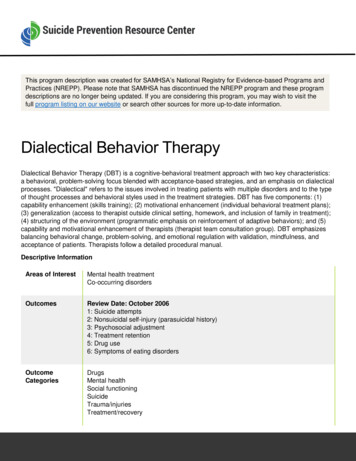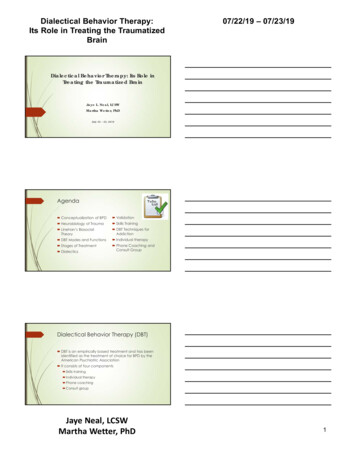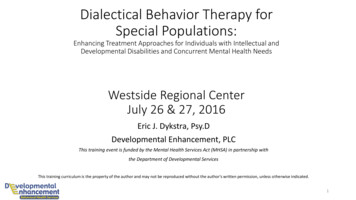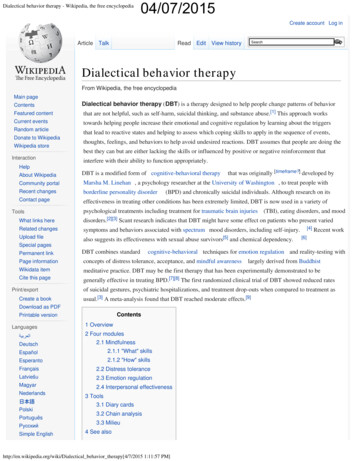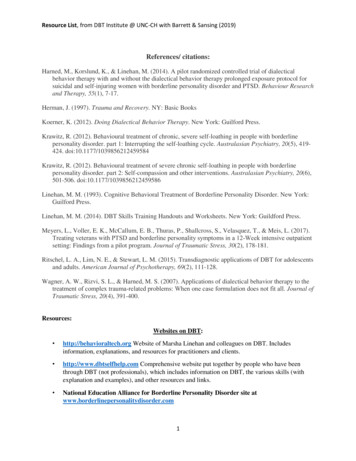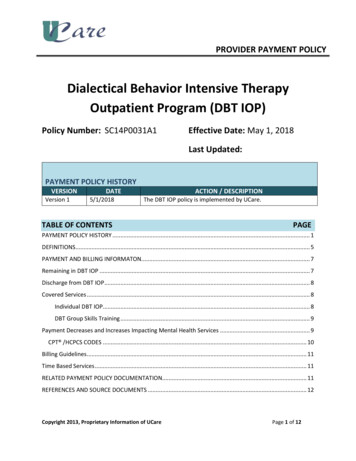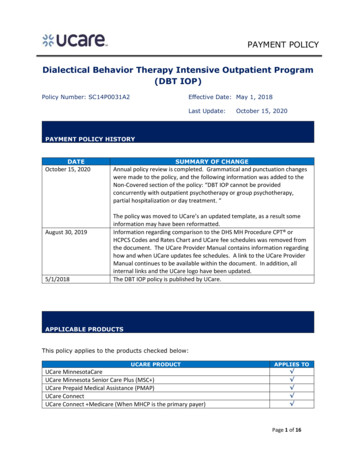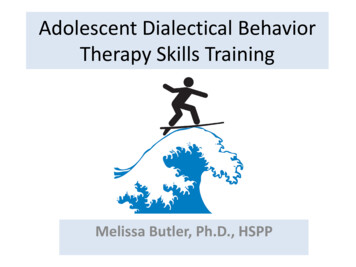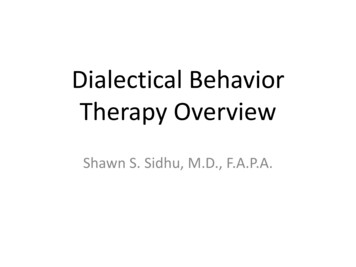
Transcription
Dialectical BehaviorTherapy OverviewShawn S. Sidhu, M.D., F.A.P.A.
QuestionWhy was Dialectical Behavior Therapy originallycreated?A. Borderline Personality DisorderB. ImpulsivityC. Bipolar DisorderD. SuicidalityE. Major Depressive Disorder
AnswerALinehan’s original work looked specifically atsuicidality, and then it was expanded toBorderline Personality Disorder.
Why Should You CareAbout DBT?
We are ineffective at predicting which patientswill end up harming themselvesA history of IMPULSIVE aggression remains thebest predictor of suicide attemptsDBT is one of the only treatments whichdirectly addresses impulsivity
Authentic, genuine, and customized. Alsosemi-structured.Multiple simultaneous components addressingseparate but important issuesCan expand for use in anyone with impulsivebehaviors (including substance abuse)
What is DBT?What is a Dialectic?
Question 2Which of the following thinking patterns is reflective of a “dialectic”?1)Persistently negative (everything is terrible and always will be)2)Catastrophizing (the fact that I am late for this meeting will ruin mywhole life)3)Black and White (my husband is perfect and my mother-in-law has noredeemable qualities)4)Paranoia (my family wants to cook for me so that they can put somethingin my food)5)Distorted Thinking (I know I am normal weight but when I look in themirror all I see is someone who is grotesque)
AnswerBlack and White (my husband is perfect andmy mother-in-law has no redeemablequalities)The other types of thinking could also bepossible in DBT patients as well!
Dialectics refer to opposing/conflicting ideas“Black and White” thinking is a hallmark ofimpulsive individualsThe point of DBT is to help patients see thingsobjectively and less extremely, and to help seethe truths in both sides
DBT started out as a therapy aimed ataddressing dialectics, but really has moved toaddressing many extremes in thinking
Examples of Extreme ThinkingIndependent Self-View: “I’m worthless” or“Everything in my life sucks and it always will”Interpersonal Self-View: “Everybody hatesme”View of Others: “My mom is the worst personin the world”Interpretation: “My dad criticized the way
What Are the Componentsof DBT?
Question 3What are the components of DBT?A)B)C)D)E)Individual Therapy/Phone CoachingSkills GroupsConsultation GroupsFamily TherapyAll of the Above
AnswerAll of the Above
DBT StructureIndividual Therapy: 1 hour per weekPhone CoachingSkills Group: 2-2.5 hour group per weekFamily Therapy/InvolvementConsultation Group: 1.5 – 2 hour group per week*None of these components have been shown to beefficacious in the absence of the others
Individual Therapy Skills/ToolsDiary CardBehavioral Chain Analysis
Diary Card
Question 4What method do DBT therapists use in individualtherapy when a patient endorses recent cutting?A.B.C.D.E.Cognitive RestructuringExposure-Response PreventionHabit Reversal TrainingBehavior Chain AnalysisInsight-Oriented Interpretation
AnswerBehavioral Chain Analysis
Behavioral Chain Analysis
Guidelines for a Behavioral Chain Analysis1) Describe the specific PROBLEM BEHAVIOR (examplecutting or a suicide attempt)A) Be very specific and detailed. Avoid vague terms.B) Identify exactly what you did, said, thought, or feltC) Describe the intensity of the behavior and other characteristicsof the behavior that are importantD) Describe the problem behavior in enough detail that an actor ina play or movie could recreate the behavior exactly
Guidelines for a Behavioral Chain Analysis2) Describe the specific PRECIPITATING EVENT that started the whole chainA)Identify the environmental event that startedthe chain. Always start with some event in yourenvironment, even if it doesn’t seem to you that1) When did the sequence of events that led to the problemthebehaviorenvironmentalcausedthe problembegin? When eventdid the problemstart?behavior. Here are some possible questions to2) What was going on the moment the problem started?get to this:3) What were you doing, thinking, feeling, and imagining at thetime?4) Why did the problem behavior happen on that day instead of theday before?
Guidelines for a Behavioral Chain Analysis3) Describe the VULNERATBILITY FACTORS happening before the precipitatingevent. What factors or events made you more vulnerable to a problematicchain? Areas to examine include the following:A.B.C.D.Physical illness, unbalanced eating or sleeping, injuryUse of drugs or alcohol, misuse of prescription drugs Stressful eventsin the environment (positive or negative)Intense emotions, such as sadness, anger, fear, or lonelinessPrevious behaviors of your own that you foundstressful
Guidelines for a Behavioral Chain Analysis4) Describe in excruciating detail the CHAIN of EVENTS that led up to the problem behavior* Imagine that your problem behavior is chained to the precipitating even tin the environment.How long is the chain? Where does it go? What are the links? Write out all links in the chain ofevents, no matter how small. Be very specific, as if you are writing a script for a play.A. What exact thought (or belief), feeling, or action followed the precipitating event? Whatthought, feeling, or action followed that? What next? What next?B. Look at each link in the chain after you write it. Was there another thought, feeling, oraction that could have occurred? Could someone else have thought, felt, or acteddifferently at that point. If so, explain how that specific thought, feeling or action came tobe.C. For each link in the chain, ask yourself: is there a smaller link I could describe?
Guidelines for a Behavioral Chain Analysis5) What were the CONSEQUENCES of thisbehavior? Be specific. How did other peoplereact immediately and later? How did you feelimmediately following the behavior? Howabout later? What effect did the behavior haveon you and your environment?
Guidelines for a Behavioral Chain Analysis6) Describe in detail different SOLUTIONS to the problemA. Go back to the chain of your behaviors following the prompting event.Circle each point or link where, if you had done something different,you would have avoided the problem behaviorB.What could you have done differently at each link in the chain of theevents to avoid the problem behavior? What coping behaviors orskillful behaviors could you have used?
Guidelines for a Behavioral Chain Analysis7) Describe in detail a PREVENTION STRATEGY for how you could have keptthe chain from starting by reducing your vulnerability to the chain.8) Describe what you are going to do to REPAIR important or significantconsequences of the problem behavior
SKILLS GROUPS
Question 5Which of the following could be considered a“mindfulness” exercise?A.B.C.D.E.Creating a fear ladder/hierarchyTaking a walk while noting the sightsDirectly addressing uncomfortable emotionsDistracting the mind from negative thoughtsProviding gentle aversive therapy to maladaptivebehaviors
AnswerB
MINDFULNESS
Mindfulness Training Overarching Philosophy: help patients bemore in touch with themselves and theirenvironments in the moment 3 States of the Mind What Skills How Skills
Mindfulness - 3 States of the Mind
Mindfulness - “What” Skills Observe Describe Participate
Mindfulness - “How Skills” Non-Judgementally One Mindfully Effectively
DISTRESS TOLERANCE
Distress Tolerance Learn Crisis Survival Skills. Core skillsinclude:––––Self-Soothing SkillsImprove the MomentLearn to Evaluate Pros and ConsDistract Yourself with ACCEPTS Other Skills Include:– Breathing Exercises– Half-Smiling Exercises– Turning the Mind/Radical Acceptance/Accepting Reality
Distress Tolerance – Distraction (ACCEPTS) Activities: Contributing: Comparisons: Emotions: Pushing Away:Thoughts:Sensations:
INTERPERSONAL EFFECTIVENESS
Interpersonal Effectiveness Keeping Relationships with GIVE Keeping Self-Respect with FAST Getting What you Want with DEAR MAN Factors Reducing Interpersonal Effectiveness Self-Affirming Statements for Interpersonal Effectiveness Looking into Asking for What You Want/Saying No
GIVE and FAST be Gentle act Interested Validate use an Easy manner be Fair no Apologies Stick to your values be Truthful
DEAR MAN Describe Express Assert Reinforce stay Mindful Appear confident Negotiate
EMOTIONAL REGULATION
Emotion Regulation Reducing vulnerability to negative emotions via PLEASEMASTER Letting go of emotional suffering Mindfulness of the current emotion Changing emotions by acting opposite to the current emotion Steps for increasing positive emotions
PLEASE MASTER PhysicaL illnessbalance EatingAvoid mood-Altering drugsbalance Sleepget Exercisebecome a MASTER/build MASTERy
Questions?E-mail: Ssidhu@salud.unm.edu
Dialectical Behavior Therapy Author: SSidhu@salud.unm.edu Keywords: Dialectical Behavio
